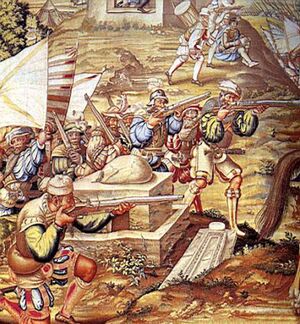Conquest of Al-Raha (1546): Difference between revisions
No edit summary |
|||
| (One intermediate revision by one other user not shown) | |||
| Line 35: | Line 35: | ||
==Aftermath== | ==Aftermath== | ||
The victory in Al-Raha did not last long. The Riysan army would recapture the | The victory in Al-Raha did not last long. The Riysan army would recapture the territory from Tiberius III's successor, [[Publius II]], in 1612. | ||
[[Category:Astyria]][[Category:Wars of Astyria]][[Category:Blackhelm Confederacy]][[Category:Wars involving the Empire of Exponent]] | [[Category:Astyria]][[Category:Wars of Astyria]][[Category:Blackhelm Confederacy]][[Category:Wars involving the Empire of Exponent]] | ||
Latest revision as of 04:35, 17 January 2023
| Conquest of Al-Raha | |||||||||
|---|---|---|---|---|---|---|---|---|---|
 Imperial soldiers in battle | |||||||||
| |||||||||
| Belligerents | |||||||||
|
|
| ||||||||
| Commanders and leaders | |||||||||
|
Tiberius III Lucius Antyllus Arelius Serranus Quintus Selius | Fawzi al-Subhi | ||||||||
| Strength | |||||||||
|
60,000 men 120 ships |
10,00 men 20 ships | ||||||||
| Casualties and losses | |||||||||
| Unknown |
Unknown, many civilian casualties 20 ships destroyed | ||||||||
The Conquest of Al-Raha in 1546 was an attack on Al-Raha, then under the control of Riysa, by the Empire of Exponent.
Background
Seeking to continue to expand into Astyria, Tiberius III eyed the peninsula of Al-Raha, just across the Mare Ferum from Hesperidesia. Believing it to be his divine right to expand, coupled with the idea of conquering a non-Christian state and spreading Catholicism, Tiberius organized a large fleet and prepared to seize the territory. The cost of such an expedition was considerable, but funds were raised quickly by glory seeking nobles, and in a short time the expedition was underway,
On the Riysans part, there was no inkling that such a large attack was about to crash into them, and the peninsula remained relatively lightly defended. 10,000 men, stationed in various parts of the territory, as well as twenty ships of varying sizes were all that stood in the path of the Imperial forces.
Battle
On June 8, 1546, Tiberius III destroyed Fawzi al-Subhi's fleet and, after a costly yet successful siege at Deir Yasmin, moved on to capture the capital at Hamdan. The resulting massacre of the city left an estimated 30,000 dead. Al-Subhi managed to escape back to the Riysan mainland with a host of troops and refugees, avoiding the fate of many of his less fortunate countrymen. The stench of the corpses was such that Tiberius III soon left Hamdan and moved his camp outside the city.
The siege demonstrated the power projection of the Exponentia dynasty at the time; Tiberius III had under his control all of Hesperidesia, islands throughout the Mare Ferum, and would soon begin taking territory in Aquitayne, to the north.
Tiberius III celebrated his triumph "over the infidel" in Paradisa on May 5, 1547 and had a massive bronze statue constructed in the city in commemoration of his victory at Al-Raha.
Aftermath
The victory in Al-Raha did not last long. The Riysan army would recapture the territory from Tiberius III's successor, Publius II, in 1612.